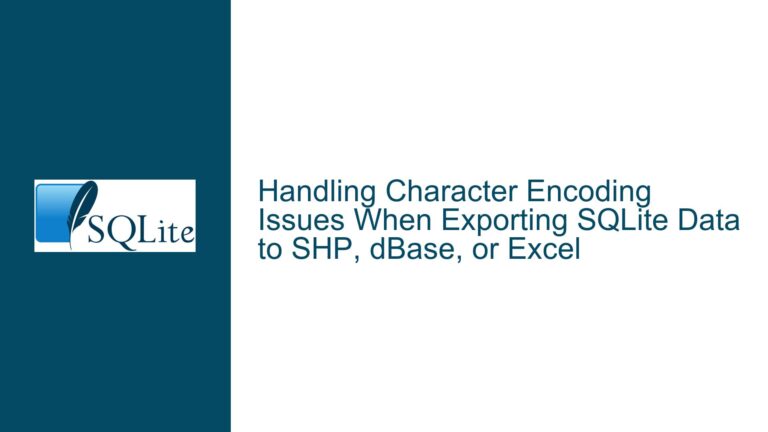Implementing ISO 8601 Week Dates in SQLite: Custom strftime Formats and Conversion Challenges
Understanding ISO 8601 Calendar Representation in SQLite Date Functions
The ISO 8601 calendar system introduces a week-based date format that differs from the traditional Gregorian calendar. This system defines years as having 52 or 53 weeks, with weeks starting on Monday. The format yyyy-Www-d represents the ISO year (yyyy), ISO week number (ww), and ISO weekday (d, where Monday=1 to Sunday=7). SQLite’s native strftime function lacks direct support for this format, necessitating custom implementations. Two distinct approaches emerge:
- A patch introducing the
%iformat specifier to outputyyyy-Www-d. - An alternative patch using
%G,%V, and%u(matching POSIX conventions) for ISO year, week number, and weekday.
A critical challenge arises in bidirectional conversion: generating ISO 8601 dates from Julian/Gregorian dates and reconstructing Julian/Gregorian dates from ISO 8601 strings. The complexity stems from edge cases like week 53, leap years, and year transitions where the ISO year differs from the Gregorian year.
Algorithmic Complexities in ISO Week Calculations and Reverse Engineering
1. ISO Week Number Computation
The ISO 8601 standard defines the first week of the year as the one containing at least four days in January. This leads to scenarios where the first days of January belong to week 52/53 of the previous year, or the last days of December belong to week 1 of the next year. The provided %i patch calculates this by:
- Determining the day of the year (
DayOfYearNumber). - Calculating the weekday of January 1st (
Jan1Weekday). - Adjusting the year and week number based on whether the date falls in the "overflow" regions (first few days of January or last few days of December).
The isLeapYear function is critical for handling year-length variations, influencing week 53 eligibility. The alternative %G/%V/%u patch avoids leap year checks by relying on modular arithmetic and Julian Day Number (JDN) manipulations, which introduces different trade-offs in accuracy and performance.
2. Reverse Conversion: ISO to Gregorian Dates
Translating yyyy-Www-d back to a Gregorian date requires:
- Calculating the JDN of the first day of the ISO year.
- Adjusting for the target week and weekday.
- Handling edge cases where the ISO year differs from the Gregorian year.
This process is complicated by the lack of built-in SQLite functions to parse ISO week dates. Developers must manually decompose the ISO string and compute the corresponding JDN using arithmetic operations.
3. Divergent Implementations and Compatibility
The coexistence of multiple patches (%i vs. %G/%V/%u) creates compatibility concerns. For example, %i outputs a combined yyyy-Www-d string, while %G/%V/%u requires combining three specifiers. Systems relying on one patch may fail to interpret dates generated by the other, leading to data inconsistencies.
Strategies for Implementation, Validation, and Cross-Format Conversion
1. Implementing the %i Specifier
Step 1: Apply the Custom Patch
Integrate the provided C code into SQLite’s date.c source:
- Add the
isLeapYearhelper function. - Extend the
strftimeswitch statement with the%icase. - Recompile SQLite with the modified
date.c.
Validation:
Test edge cases:
-- December 31, 2022 (ISO year 2022, week 52, day 6)
SELECT strftime('%i', '2022-12-31'); -- Expect '2022-W52-6'
-- January 1, 2023 (ISO year 2022, week 52, day 7)
SELECT strftime('%i', '2023-01-01'); -- Expect '2022-W52-7'
-- January 1, 2025 (ISO year 2025, week 1, day 3)
SELECT strftime('%i', '2025-01-01'); -- Expect '2025-W01-3'
2. Converting ISO 8601 Strings to Gregorian Dates
Step 1: Parse the ISO Components
Use substr and CAST to extract year, week, and day:
WITH iso_date(iso_str) AS (VALUES ('2022-W52-6'))
SELECT
CAST(substr(iso_str, 1, 4) AS INTEGER) AS iso_year,
CAST(substr(iso_str, 7, 2) AS INTEGER) AS iso_week,
CAST(substr(iso_str, 10, 1) AS INTEGER) AS iso_weekday
FROM iso_date;
Step 2: Compute the First Thursday of the ISO Year
The first week of the ISO year contains the year’s first Thursday. Calculate the JDN for January 4 of the ISO year, adjusted to the nearest Thursday:
-- Compute base JDN for January 4 of the ISO year
jdn_base = julianday(iso_year || '-01-04')
- (CAST(strftime('%w', iso_year || '-01-04') AS INTEGER) + 6) % 7;
Step 3: Calculate the Target JDN
Offset from the base JDN by (iso_week - 1) * 7 + (iso_weekday - 1):
jdn_target = jdn_base + (iso_week - 1) * 7 + (iso_weekday - 1);
Full Query Example:
SELECT date(julianday(iso_year || '-01-04')
- ((CAST(strftime('%w', iso_year || '-01-04') AS INTEGER) + 6) % 7)
+ (iso_week - 1) * 7
+ (iso_weekday - 1)) AS gregorian_date;
3. Comparing %i and %G/%V/%u Approaches
Pros of %i:
- Single specifier for complete ISO date.
- Output matches
yyyy-Www-dexactly.
Cons of %i:
- Requires leap year checks, which may introduce computational overhead.
- Non-standard specifier, reducing portability.
Pros of %G/%V/%u:
- Aligns with POSIX standards, improving interoperability.
- Separates components for flexible formatting.
Cons of %G/%V/%u:
- Requires combining three specifiers:
strftime('%G-W%V-%u', ...). - Potential misalignment with other systems’ week numbering.
4. Handling Leap Years and Week 53
Scenario: A date belongs to week 53 of the previous ISO year (e.g., January 1, 2023).
Solution: When reversing ISO to Gregorian, ensure the computed JDN accounts for year transitions:
-- Example: Convert '2022-W53-1' (if valid)
WITH iso_date AS (SELECT '2022' AS y, 53 AS w, 1 AS d)
SELECT date(julianday(y || '-01-04')
- ((CAST(strftime('%w', y || '-01-04') AS INTEGER) + 6) % 7)
+ (w - 1) * 7
+ (d - 1)) AS gregorian_date;
-- Returns NULL if week 53 does not exist for the year; add validation.
Validation:
Check if the computed week 53 exists using isLeapYear logic or JDN bounds.
5. Optimizing for Performance
Indexing ISO Dates:
Store precomputed ISO date components in virtual columns for faster querying:
CREATE TABLE events (
id INTEGER PRIMARY KEY,
gregorian DATE,
iso_year GENERATED ALWAYS AS (CAST(strftime('%G', gregorian) AS INTEGER)),
iso_week GENERATED ALWAYS AS (CAST(strftime('%V', gregorian) AS INTEGER)),
iso_weekday GENERATED ALWAYS AS (CAST(strftime('%u', gregorian) AS INTEGER))
);
Batch Conversions:
For large datasets, precompute Gregorian-to-ISO mappings outside SQLite (e.g., during ETL) to avoid on-the-fly calculations.
By addressing these facets—algorithmic implementation, bidirectional conversion, edge cases, and performance considerations—developers can robustly integrate ISO 8601 week date functionality into SQLite applications.






